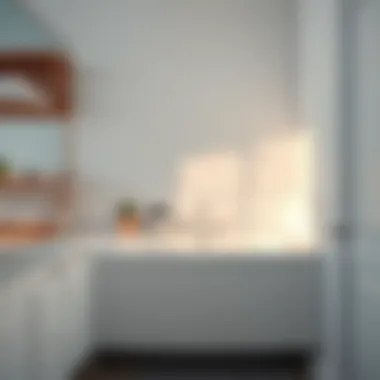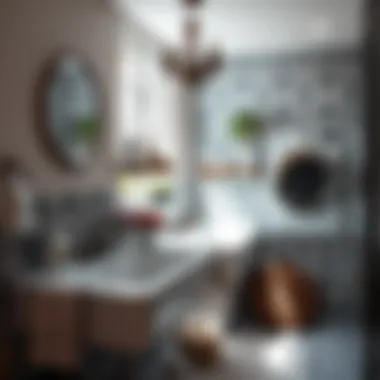Exploring the Diverse Aspects of Laundry Sinks


Intro
Laundry sinks, often overshadowed by their flashier counterparts, play a crucial role in the organization and functionality of modern laundry spaces. As households evolve, the importance of these utility basins has become more evident. They are no longer merely utilitarian; instead, they have emerged as essential components of home design, marrying practicality with aesthetic appeal. This article explores the nuanced world of laundry sinks, spotlighting their integral role in everyday chores and home aesthetics.
As we dive into this topic, we will unpack the diverse material options available, innovative design trends, and how these sinks contribute to efficient space management. Furthermore, we will analyze essential features and maintenance strategies, ensuring homeowners can choose and care for laundry sinks that elevate their spaces effectively. Whether you're designing a brand-new laundry room or giving an existing one a facelift, understanding these elements can make a world of difference. Join us as we embark on this journey to comprehend the essential role of laundry sinks in enhancing not just functionality but also the overall look of your home.
Understanding the Purpose of Laundry Sinks
Laundry sinks serve as more than just a convenience in households; they embody the blend of functionality and creativity in home design. Understanding their role is vital for homeowners looking to maximize both utility and aesthetic appeal in their laundry spaces. A well-designed laundry sink can enhance a home’s efficiency while serving as a stylish element that complements the surrounding decor.
Historical Context
Historically, laundry sinks were simple basins made from stone or clay, found in various settings from farms to urban homes. In earlier days, they played a pivotal role in domestic life, as washing clothes by hand was a common practice. Farmers often utilized these sinks for soaking clothes and cleaning various tools, while city dwellers relied on them to manage laundry in cramped quarters.
Over the decades, as technology advanced, so did the design and materials of these sinks. The introduction of indoor plumbing made laundry more efficient, allowing homeowners to integrate specialized sinks into their designs. Stainless steel and porcelain became popular due to their durability and ease of cleaning. As we look back, the evolution of laundry sinks reflects changes in domestic practices and societal needs, illustrating how integral they were and continue to be in modern households.
Contemporary Applications
Today, the applications of laundry sinks have expanded significantly beyond typical washing tasks. They have become central features in laundry rooms, serving various purposes including:
- Pre-soaking and Stain Treatment: Laundry sinks are ideal for treating stubborn stains with solutions before they hit the main wash cycle. This can save time and resources.
- Gardening and Cleaning Tools: Theses sinks provide a convenient space for rinsing off muddy boots or washing gardening tools without clogging kitchen sinks.
- Pet Grooming Station: Pet owners have found laundry sinks to be an excellent spot for bathing their furry friends, keeping the mess contained and convenient.
- Crafting and Hobbies: Many craft enthusiasts utilize laundry sinks for washing brushes, rinsing paint, or even preparing materials without the fear of damaging their kitchen interiors.
The versatility of modern laundry sinks allows them to adapt to the diverse needs of households, emphasizing their continual relevance in contemporary home design. With thoughtful consideration of their purpose and applications, homeowners can enhance the functionality of their laundry areas significantly.
Selecting the Right Laundry Sink
Choosing the right laundry sink is not just about functionality, but also about integrating it seamlessly into your home's design. It can significantly impact your laundry room's efficiency and aesthetics, making careful selection paramount. The right sink caters to specific needs—whether washing delicate clothing, soaking stained items, or even small tasks like rinsing out paintbrushes. The wrong choice could lead to frustrations down the line, such as inadequate capacity, compatibility issues with existing plumbing, or simply an eyesore in an otherwise harmonious space.
Understanding how to select a laundry sink involves grasping the interplay between size, material, and style. All these factors contribute to the sink's performance and your satisfaction. Thus, aligning your selection with personal preferences and practical requirements will ensure that your laundry space is not only functional but also pleasing to the eye.
Sizing Considerations
When it comes to sizing, the dimensions of your laundry sink can make or break its usability. A sink that is too small might restrict what you can wash, while one that’s overly large may not fit well in your space. It's crucial to measure the dimensions of the designated area thoroughly. Standard laundry sinks typically range from 20 to 25 inches in width, and an adequate depth of at least 12 inches is recommended for soaking bulky items.
Here are a few points to consider while sizing:
- Proportion to Space: Ensure it complements the laundry room layout without overpowering.
- Functionality: If you plan on using it for heavy-duty tasks, larger capacities may be required.
- Accessibility: Make sure it’s placed at a height that’s comfortable for regular use to avoid strain.
Material Options
The choice of material for your laundry sink is just as critical as its size. Various materials offer unique benefits and drawbacks, impacting durability, maintenance, and overall visual appeal. Here’s a breakdown of popular materials:
Stainless Steel
Stainless steel is known for its durability and clean contemporary look, making it a staple in laundry rooms. It resists rust and corrosion. This feature is especially useful in a wet environment like a laundry room. Furthermore, its sleek surface allows for easy cleaning, which is a big plus. However, be wary of scratches; they can become noticeable with regular use.
Cast Iron
Cast iron offers a sense of timeless elegance with its classic design. Its thick walls maintain heat, which can be beneficial for washing stubborn stains. Additionally, it's very sturdy and can endure heavy usage. However, it tends to be heavier and may require additional support. On the downside, cast iron often comes with a higher price tag, making it a splurge for some.
Composite Materials
Composite sinks, created from a blend of materials, present a good mix of aesthetic appeal and strong performance. These sinks are typically resistant to scratches and stains, meaning they stay looking new longer. They can be molded into various shapes and styles, allowing for creativity. Nevertheless, it’s essential to ensure you find a composite that is UV resistant since fading can occur over time in bright laundry rooms.
Enamel Coated
Enamel-coated sinks provide a classic look with a smooth surface that is easy to clean. They add a pop of color to your laundry area, which can brighten up the space. Despite their charm, they can chip if heavy objects are dropped, leading to potential rust underneath the enamel. Thus, caution is necessary when using them.
Style Variations
The style of your laundry sink is equally important as it affects both the functionality and design of the space.
Undermount
Undermount sinks offer a seamless appearance that many homeowners appreciate. They create an uninterrupted surface, which makes cleaning the countertop easier. They’re usually installed below a counter, allowing for a streamlined look. Yet, be prepared for potential extra installation costs since they require specialized countertops.
Drop-in
Drop-in sinks are perhaps the most straightforward to install, coming in many sizes and styles. They simply drop into a hole cut into your countertop. This allows for easy replacement, which is a benefit if you plan to renovate in the future. However, they might not have the seamless look that some prefer, leaving a lip around the sink where dirt could gather.
Wall-mounted


Wall-mounted sinks can save space and create a unique aesthetic. These sinks are attached directly to the wall, making them perfect for smaller laundry rooms or even utility areas. They can be a bit tricky during installation as you have to ensure proper wall support. But they provide easy access underneath for plumbing and storage.
Incorporating Laundry Sinks in Home Design
In today’s modern homes, laundry sinks play a pivotal role, not only from a functional perspective but also as a key design element. When considering the overall layout, integrating a laundry sink can enhance both utility and aesthetics in your space. Whether you are designing your laundry room or including a sink in a multi-purpose area, understanding how to incorporate these fixtures thoughtfully can elevate the entire design.
Integration with Laundry Rooms
When you think of a laundry room, the appliances often steal the show. However, a laundry sink is crucial here, providing a dedicated space for tasks that require more than just a washing machine. Perhaps you've got heavy loads of laundry or maybe some delicate items needing a gentle rinse – having a sink nearby can save you a trip to the bathroom or kitchen.
Plus, many homeowners today are opting for open-plan layouts, where laundry areas might be visible from the living spaces. The design choices made here can reflect personal style and contribute to a cohesive look throughout the home. Consider selecting a laundry sink that matches the cabinetry or countertop materials in the room, ensuring a fluid transition between spaces.
Benefits of Integration
- Increased Functionality: With a laundry sink, you have a place to pre-soak stains, wash out dirty items, or even hand wash delicates without splashing all over the kitchen or bathroom.
- Time-Saver: Minimizing trips to different areas of the house can be a huge win, especially during peak laundry days.
- Enhanced Aesthetics: Choosing a stylish sink can act as a centerpiece, enhancing the overall look of the laundry area.
One might want to think about location too. If your laundry is close to the back door, a sink can also serve as a convenient space for rinsing off muddy shoes or dog paws before entering the main living areas.
Standalone Laundry Sinks
Standalone laundry sinks are making a splash, quite literally, in home design. Unlike integrated sinks that are often built into cabinetry, standalone options provide total versatility. These freestanding elements can be positioned wherever you need them, offering flexibility based on your specific laundry workflow.
Key considerations
- Material Selection: Opt for materials like stainless steel or cast iron that not only withstand heavy use but add a touch of elegance. Composite sinks are also gaining ground: they're durable and come in various colors and shapes.
- Space Optimization: If space allows, incorporating a larger standalone sink can enhance functionality, making it easier to handle oversized items or bulky cleaning tasks.
- Style and Decor: Standalone sinks can come in various styles, from farmhouse chic to sleek modern designs. Your choice can truly make a statement, coordinating with other elements in the room or standing out as a focal point.
A laundry sink, while often overlooked, is an investment in both practicality and style, turning a mundane task into a more enjoyable experience.
Ultimately, incorporating a laundry sink into home design should be a reflection of individual needs and lifestyle. Whether you opt for an integrated sink as part of a laundry suite or a standalone piece, the right choice can transform a simple utility area into a functional and stylish space.
Sustainability in Laundry Sinks
Sustainability has taken center stage in modern home design, and laundry sinks are no exception. In a world where resource conservation and environmental awareness are vital, the inclusion of sustainable features in laundry sinks not only helps the planet but also promotes efficient usage in daily life. As homeowners, particularly housewives overseeing household management, it’s essential to consider how the choices in laundry sink design can play a part in a more sustainable lifestyle.
Water is one of our most precious resources. Hence, laundry sinks designed with water conservation in mind can significantly reduce waste. Consider features such as low-flow faucets and aerators, which can help minimize water use without sacrificing performance. Every drop saved counts, especially when multiplied over the years. Additionally, incorporating a laundry sink that holds the capacity for larger loads not only increases functionality but also enhances efficiency, allowing for more clothes to be washed with less water.
"A laundry sink that helps you save water and energy, that’s a win-win for your home and the planet."
Furthermore, when selecting eco-friendly materials, it’s important to look beyond appearance. Many sinks are now crafted from sustainable resources or recycled materials that are durable and functional. For instance, sinks made of composite, a blend often including recycled content, can offer the strength of traditional materials while reducing the environmental impact. These choices are not merely about aesthetics; they reflect a commitment to sustainability and responsible consumerism.
Water Conservation Features
Several innovative designs and technologies focus primarily on reducing water usage in laundry sinks. Here are some features to look for:
- Low-flow faucets: Designed to limit the amount of water that flows out without compromising spray power, making them ideal for rinsing items quickly.
- Dual-action taps: These allow homeowners to switch between a streamlined flow for washing and a higher pressure for rinsing.
- Tankless sink heaters: For homeowners who prioritize hot water, these heaters on demand help avoid wasting energy associated with traditional water heating methods.
- Flow control valves: These devices can be installed to regulate and control the amount of water released, ensuring efficient use.
Eco-Friendly Materials
Opting for sustainable materials can have a substantial impact on the overall state of the environment. When looking for laundry sinks, consider:
- Composite materials: Typically formed from crushed stone or recycled plastics, these sinks offer durability while being kind to the environment. They also come in various colors and finishes, complementing diverse home aesthetics.
- Recycled stainless steel: A popular choice that ensures strength and longevity, this material can be sourced from previously used products. It’s resistant to rust and offers a hygienic surface for easy cleaning.
- Bamboo sinks: Emerging as an alternative, bamboo is a renewable resource that, when treated properly, can withstand the rigors of daily usage.
- Ceramic or porcelain: Sinks made from these materials can often be crafted from recycled components, providing an eco-sensitive choice that doesn’t compromise on design.
Maintaining Your Laundry Sink
Maintaining your laundry sink is vital for ensuring it serves its purpose efficiently and remains an appealing feature in your home. Regular upkeep doesn't just enhance the lifespan of your sink; it also keeps your laundry area looking its best. Routine maintenance helps prevent a range of issues that could escalate into costly repairs or replacements. With a bit of daily care and an understanding of deep cleaning strategies, you can keep your laundry sink in tip-top shape for years to come.
Daily Care Tips
A little attention goes a long way in maintaining a laundry sink. Here are some daily care tips:
- Rinse After Use: Every time you use the sink, a quick rinse can prevent buildup. This simple act removes soap residue or dirt, ensuring that nothing sticks.
- Wipe Down Surfaces: Use a soft cloth to wipe the sink and countertop after each use. It helps to keep grime from accumulating and enhances the sink's overall shine.
- Prevent Blockages: Avoid rinsing down food particles or non-laundry items. Consider keeping a small bin nearby for anything that should not go down the drain.
These practices may sound small, but they can prevent most common issues encountered with laundry sinks, such as stains or clogs.
Deep Cleaning Strategies
Removing Stains
Addressing stains is not just about aesthetics. Stains often indicate underlying problems, whether from detergents or water quality. The task of removing them effectively contributes to the maintenance of your laundry sink by keeping it hygienic. Key characteristics of effective stain removal include the use of suitable cleaning solutions and regular monitoring for any discoloration.
One unique feature is the use of baking soda and vinegar—a natural remedy that can lift many stains. This strategic blend not only combats discoloration but also acts as a mild disinfectant, making it a beneficial choice for maintaining the hygiene of the sink.
Scrubbing Techniques


Regular scrubbing is essential for keeping the sink clean. The right scrubbing technique ensures that even the most stubborn dirt or grime is addressed. A characteristic of good scrubbing is choosing appropriate materials like non-abrasive sponges that won't scratch the surface.
Using a circular motion can help dislodge built-up dirt while keeping the surface intact. This technique also allows for a thorough clean without risking damage to the sink, making it a popular choice for homeowners conscious about maintaining their laundry sink.
Dealing with Hard Water
Hard water is a notorious issue that often leaves unsightly mineral deposits on sinks. Understanding how to deal with this is critical. Not only does it improve the look of the sink, but it also prevents buildup that can lead to plumbing blockages over time.
A key characteristic of this challenge is the significance of using a vinegar solution to dissolve the mineral deposits. This method is effective and affordable, helping homeowners maintain their laundry sinks without expensive cleaners. However, it may require some elbow grease and regular applications to keep hard water stains at bay.
Identifying and Preventing Damage
Early intervention is key for maintaining a laundry sink. Identifying signs of damage can drastically reduce repair costs. Common issues include:
- Cracks or Chips: These can occur due to heavy impacts or thermal shock. Regular checks can catch these early, allowing for timely repair to prevent leaks.
- Rust: Particularly in metal sinks, rust can be an indicator of moisture retention. Proper drying after use is a preventive measure that should become routine.
- Loose Fixtures: An unstable faucet can lead to leaks over time. Inspecting and tightening connections should be part of your maintenance regimen to ensure everything remains intact.
Incorporating these practices, whether daily or periodically, can refresh your laundry sink and keep it looking great while functioning properly. The benefits go beyond mere appearance; they extend to cost savings, efficiency, and overall satisfaction with your laundry space.
Innovations in Laundry Sink Design
Innovations in laundry sink design are increasingly transforming the way we perceive and utilize these functional spaces within our homes. Gone are the days when laundry sinks served simply as a utilitarian fixture in the corner of the laundry room. Today's designs marry aesthetics with practicality, enhancing the overall laundry experience. With the growing emphasis on smart home technology and customization, laundry sinks have evolved into versatile features that can adapt to the needs of the modern household.
Smart Laundry Sinks
Incorporating smart technology into laundry sinks is a testament to how innovation is reshaping home functionalities. Smart laundry sinks come equipped with features such as touchless faucets, smart water usage monitoring, and IoT compatibility. These innovations can significantly reduce water waste, provide alerts for maintenance, and even track usage patterns.
One notable example is the Moen Smart Faucet, which integrates touchless technology, temperature control, and voice commands. Homeowners can set the exact water amount needed for a task without physical contact, which is especially beneficial for maintaining hygiene.
"Smart sinks not only simplify the chores, but they also promote a greener lifestyle by helping homeowners effectively manage water consumption."
Such advancements are particularly valuable for families, busy couples, or anyone looking to streamline their laundry processes. As technology becomes more ingrained in daily life, having a smart laundry sink can elevate your laundry room’s functionality and efficiency.
Customizable Options
Customization in laundry sink designs allows homeowners to tailor features according to their specific needs and tastes. From size to materials, a plethora of choices ensures that every laundry sink can be a unique statement piece. This level of personalization enables homeowners to create an environment that not only meets practical requirements but also resonates with individual style.
Homeowners can pick from various materials such as stainless steel, composite, or cast iron, ensuring that aesthetics match the kitchen or laundry room theme. For instance, a sleek granite composite sink can lend a modern touch, while a vintage cast iron design could invoke a classic feel.
Furthermore, homeowners can choose accessories like built-in drying racks, integrated cutting boards, or bottom grids for food preparation tasks. This versatility means you no longer need to compromise on style or function. Some innovative companies even offer modular components that can be added or swapped out as needs change, allowing for flexibility over time.
In closing, the innovations in laundry sink designs reflect a broader shift in home design philosophy, merging functionality with personalization. As technology continues to advance and tastes evolve, it’s essential for homeowners to keep these trends in mind when designing or upgrading their laundry spaces.
Decorative Elements for Laundry Spaces
In an age where form meets function, decorative elements in laundry spaces cannot be overlooked. These elements do more than just beautify; they serve practical purposes, enhance utility, and can transform an often-neglected space into an inviting segment of the home. When thoughtfully considered, the right colors, accessories, and storage solutions can create a laundry experience that's efficient and visually appealing.
Color Schemes
Selecting an appropriate color scheme for a laundry room is fundamental. Unlike other areas in the home, the laundry space often gets shunted to a corner, painted in drab, neutral shades. Yet, the right hues can bring life to the environment. Bright colors can energize, while soft pastels might create a calming effect.
Consider these points when choosing colors:
- Harmony with Adjoining Spaces: The chosen colors should ideally complement the colors of the adjacent rooms. Shades from the same color family can create a seamless flow.
- Mood Enhancement: Lively shades like yellows or light greens can uplift the mood, particularly during the mundane chore of laundry. On the flip side, muted tones may offer a soothing retreat.
- Practicality and Maintenance: Darker colors can help hide stains and wear, making them practical choices in laundry settings.
Complementary Accessories
Faucets and Fixtures
Faucets and fixtures may seem minor in the grand scheme of a laundry room, yet their choice can drastically change functionality and style. A well-chosen faucet not only aids in efficient washing but also adds sophistication to the space. High-arc faucets are especially beneficial in laundry sinks, as they offer ample space for filling buckets or washing larger items, making the task easier and mess-free.
When selecting a faucet, consider:
- Material: Stainless steel is durable and resistant to rust, making it a timeless choice. However, finishes like matte black or brass can add a trendy touch.
- Functionality: Pull-down sprayers simplify rinsing, while touchless options enhance convenience.
But, there's a flip side. High-end faucets may require more maintenance, particularly models with intricate designs that can trap grime.
Storage Solutions
Storage solutions around the laundry sink not only keep the space organized but also enhance its usability. Custom cabinetry can provide ample storage for detergents, fabric softeners, and cleaning supplies.
A few key considerations:
- Ease of Access: Shelves should be designed within easy reach. Items used frequently should not be tucked away in hard-to-reach places.
- Aesthetic Appeal: Closed cabinets can hide the clutter, while open shelving can display attractive containers or decor, striking a balance between functionality and style.
- Flexibility: Modular shelving systems are gaining traction as they can be easily adjusted to fit changing needs.


With the right design, storage solutions can significantly declutter the workspace, offering a clean and efficient approach to laundry tasks.
"A well-thought-out laundry space can make household chores feel a bit less daunting and a tad more pleasurable.”
By paying attention to color schemes, faucets and fixtures, as well as storage solutions, one does not just decorate but elevates the functionality of laundry sinks. It’s about crafting a space that’s not just a utility but an integral part of daily life where style and convenience meet seamlessly.
Addressing Common Laundry Sink Issues
When it comes to maintaining a functional laundry space, addressing common issues related to laundry sinks is crucial. These problems, while often considered minor nuisances, can escalate into bigger headaches if not handled promptly. From clogged drains to leaks causing unexpected water damage, being aware of these issues and knowing how to deal with them can save time, money, and stress. Let's unravel these common laundry sink concerns and explore effective solutions.
Clogged Drains
Clogged drains are perhaps the most frequent issue homeowners encounter with their laundry sinks. Over time, the buildup of lint, hair, and detergent residue can create blockages, which lead to slow water drainage or, in some cases, complete drainage failure. Not only is a clogged drain frustrating, but it can also lead to unsanitary conditions if water backs up.
To tackle this problem, regular maintenance is key. Here are some helpful tips to keep your laundry sink free from clogs:
- Routine Inspection: Regularly check the sink and the drain to catch any signs of blockage early.
- Use a Strainer: Installing a strainer can capture debris before it enters the drain, preventing buildup.
- Natural Cleaners: For minor clogs, consider using a mixture of baking soda and vinegar to break down gunk. Pour half a cup of each down the drain, let it work its magic for about 30 minutes, then flush with hot water.
If a clog does occur, don’t panic. For persistent blockages, a plumber's snake can help reach deeper clogs, while professional services might be necessary in severe cases. Remember, regular maintenance can save you a world of trouble.
“An ounce of prevention is worth a pound of cure.” This saying holds particularly true for maintaining your laundry sink.
Leaks and Water Damage
Leaks in laundry sinks pose a different kind of threat. A dripping faucet might seem trivial at first, but over time that constant drip can lead to water stains, mold growth, and potential structural damage to surrounding areas.
To effectively manage leaks, it’s important to identify the source. Here are some common culprits:
- Faucets: Check if the faucet head or handle is loose. Sometimes, a simple tightening is all that’s needed.
- Supply Lines: Inspect hoses for any signs of wear or damage. If you see corrosion or cracks, consider replacing them.
- Sink Basin: Ensure the sink itself is intact. Small cracks can develop over time and lead to leaks, particularly with heavy usage.
To prevent leaks, routine checks every few months can go a long way. If you spot any issues, addressing them immediately can help you avoid extensive damage. If a leak persists, consulting with a professional is advisable. They can perform a thorough assessment and recommend necessary repairs.
Storage Solutions Near Laundry Sinks
In any home, especially in laundry rooms, effective storage solutions can make a world of difference. When you position storage options close to your laundry sink, it allows for a seamless workflow when managing laundry. This setup not only keeps essential items within arm’s reach but also contributes to a more organized and functional space.
Cabinetry Options
Choosing the right cabinetry can truly elevate your laundry area. Cabinets should ideally blend functionality with style, providing ample storage while complementing your overall decor.
- Base Cabinets: These offer a great depth for larger supplies, such as detergent, softeners, or extra cleaning supplies, allowing you to conveniently store everything out of sight.
- Wall Cabinets: Utilizing vertical space is crucial in a laundry area. Wall-mounted cabinets keep things accessible while freeing up counter space, which can be utilized for folding clothes or sorting.
- Utility Cabinets: If you have space, consider deeper utility cabinets that can hold larger items like laundry baskets or vacuum cleaners. They can act as a multi-purpose storage solution.
- Custom Cabinets: For homeowners wanting a personal touch, custom cabinetry can be designed to fit specific needs and aesthetic preferences. These can be designed to perfectly align with your laundry sink layout.
Each option has its unique pros and cons, but ultimately, it’s about striking the right balance of accessibility and style in your specific space.
Shelving Ideas
In tandem with cabinetry, shelving offers additional versatility and can often serve decorative purposes. Here are some practical shelving ideas to maximize functionality while retaining a pleasant appearance:
- Open Shelves: Perfect for storing everyday essentials or decorative items. They provide a clean look that allows easy access to products while maintaining an organized aesthetic.
- Overhead Shelves: Installing shelves above the sink or in the laundry area can greatly utilize otherwise wasted space. Keep infrequent items here while keeping your main work surfaces clear.
- Corner Shelves: Often overlooked, corner shelves can be fitted into spaces that are otherwise tough to utilize. They can carry items you access less frequently but still want close by.
- Ladder Shelves: These not only offer multiple levels of storage but can also double as a design element, making your laundry space feel stylish.
Organizing cleverly around your laundry sink means that busyness doesn’t prevent cleanliness. Everything from detergents to cloths can find a place nearby, ensuring that tasks flow without a hitch.
"The key to a functional laundry room is not just the right appliances, but how you make the space work for you with adequate storage solutions."
To sum it up, investing in tailored cabinetry and shelves can significantly improve how your laundry space functions. With the right choices, you can create a workflow that is not just efficient but also visually appealing.
The Role of Laundry Sinks in Modern Living
In contemporary homes, laundry sinks have taken on a significance that exceeds mere utility. They serve as multifunctional spaces that streamline laundry tasks, manage mess, and even provide a touch of style to otherwise utilitarian areas. Understanding their role can help homeowners maximize these often-overlooked features in their laundry rooms.
Enhanced Functionality
Laundry sinks are more than just receptacles for dirty clothes; they are versatile tools that aid in various tasks. For instance, you can use them for pre-soaking stubborn stains or washing delicate items that can’t withstand the rigors of a washing machine. Their spacious design accommodates larger items like comforters or sports gear easily.
- Washing Pets: Homeowners often find that a laundry sink provides an ideal space for bathing their pets, keeping water contained and messes manageable.
- Gardening Needs: A laundry sink can serve as a place for washing off tools or plants before coming indoors, further bridging functionality with other household tasks.
- Art Projects: Those who enjoy arts and crafts may utilize a sink in the laundry room to clean brushes or pour out unwanted materials, keeping the mess from spreading.
The additional depth of a laundry sink, often deeper than standard kitchen sinks, ensures that splashes and spills remain contained, showcasing its practicality in numerous scenarios. By integrating a laundry sink, you often save time and minimize clutter in your home, ultimately enhancing the overall functionality of the laundry space.
Design Trends
As homes evolve, so too do the aesthetics associated with them. Laundry sinks have begun to reflect a variety of styles that align with current trends. Sleek, modern designs are becoming increasingly prominent, moving away from old-fashioned, blocky shapes.
- Material Choices: With options like stainless steel, cast iron, and composite materials, homeowners can now select sinks that match their personal style while also meeting their needs for durability and maintenance.
- Color Palettes: Recent trends have leaned towards eye-catching colors. Saturated hues or subtle monochromes can transform a basic laundry sink into a focal point.
- Minimalistic Approaches: Many homeowners are gravitating towards streamlined designs, integrating their sinks into countertops for a modern, cohesive look.
Notably, laundry sinks are also increasingly being equipped with smart features, such as touchless faucets and integrated drying racks. Such enhancements not only appeal to tech-savvy individuals but also add numerous practical benefits to daily tasks, streamlining mundane processes.
Integrating modern designs with enhanced functionality reflects the evolving demands of today's households. These spacious features are designed not just to cope but also to complement the busy lifestyles of modern living.
In summary, the role of laundry sinks in modern living is defined not merely by their functionality but by how they weave into the aesthetic and practical threads of home design. Understanding these elements can guide homeowners in making informed choices that elevate their laundry spaces while reflecting personal style.















